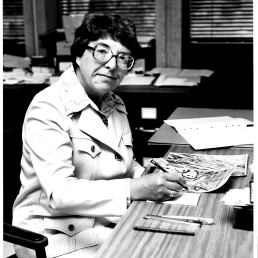The University of Toronto Community lost an eminent scholar on October 24th with the passing of Professor Betty Ida Roots, PhD, DSc, FRSC. She served the University in a number of roles; as Professor at U of T from 1969, Assistant Chair of Zoology beginning in 1972, Associate Dean of Science at UTM (then Erindale College) from 1976 and Chair of the Department of Zoology (now CSB and EEB) from 1984-1990. Roots planned, established, and directed the Electron Microscope Facility at UTM. One of her many lasting legacies is the collaborative Ph.D. program in Neuroscience at the University of Toronto, which she initiated and developed. Her friend Professor Ellie Larsen describes her as “not only a successful scientist but also a very fine leader”.
Roots was fascinated by the function of glial cells in the nervous system and how neuron-glia relationships varied between species. She focused as well on the response of animals to changes in their environment with special reference to their nervous systems. Roots was a pioneer in using electron microscopes to photograph and analyze molecular details within the cells of the nervous system. She published more than one hundred papers in scientific journals and authored, co-authored and edited a number of books including “Nerve membranes. A study of the biological and chemical aspects of neuron-glia relationships”.
Roots supervised many doctoral students in neuroscience in her laboratory, including the first neuroscientist in space, Dr Roberta Bondar. Roots primarily taught undergraduate courses on subjects related to animal physiology, electron microscopy, and neurobiology. She was an avid student and photographer of the macroscopic world of nature, teaching a course in Photography for Ecologists through her 60s with Professor Ellie Larsen.
Larsen relates that “Betty was what one would call “down to earth” and an exceedingly good evaluator of students after brief chats. She would detect their strengths and weaknesses and encourage their strengths. I recall one student who started the course on the “wrong foot” and Betty discovered that he was putting himself through university by repairing mainframe computers. She immediately enlisted him in solving our camera electronic problems and he ended up being one of the course boosters when he returned to his home University.”
Roots was born in South Croydon Surrey, England in 1927. Her early scientific curiosity led her to collect specimens around her home, and found an outlet in studies at University College at University of London, where she trained from BSc to Ph.D. in Zoology, specializing in Comparative Physiology. Dr Roots continued to conduct research in neuroscience in London, but the gender bias she faced there led her to emigrate to Canada in 1969.
Roots’ distinguished awards include a DSc from University of London, and she was an Elected Fellow of the Royal Society of Canada. In addition to pursuing an enthusiastic role with the RSC, she was active with the Royal Canadian Insititute (now RCIScience), serving as President in 1994. For the 150th anniversary of RCIScience, Roots’ ecological leadership was expressed as Editor-in-Chief of the book “Special Places: The Changing Ecosystems of the Toronto Region”, which was nominated for a Toronto Book Award. The RCIScience President at the time, Professor Kenneth Davey, says that as Editor-in-Chief, “Betty employed her characteristic powers of persuasion backed by steely determination.”
Professor Roots requested that in lieu of flowers, donations be made to the Roberta Bondar Foundation, where she was a director.

